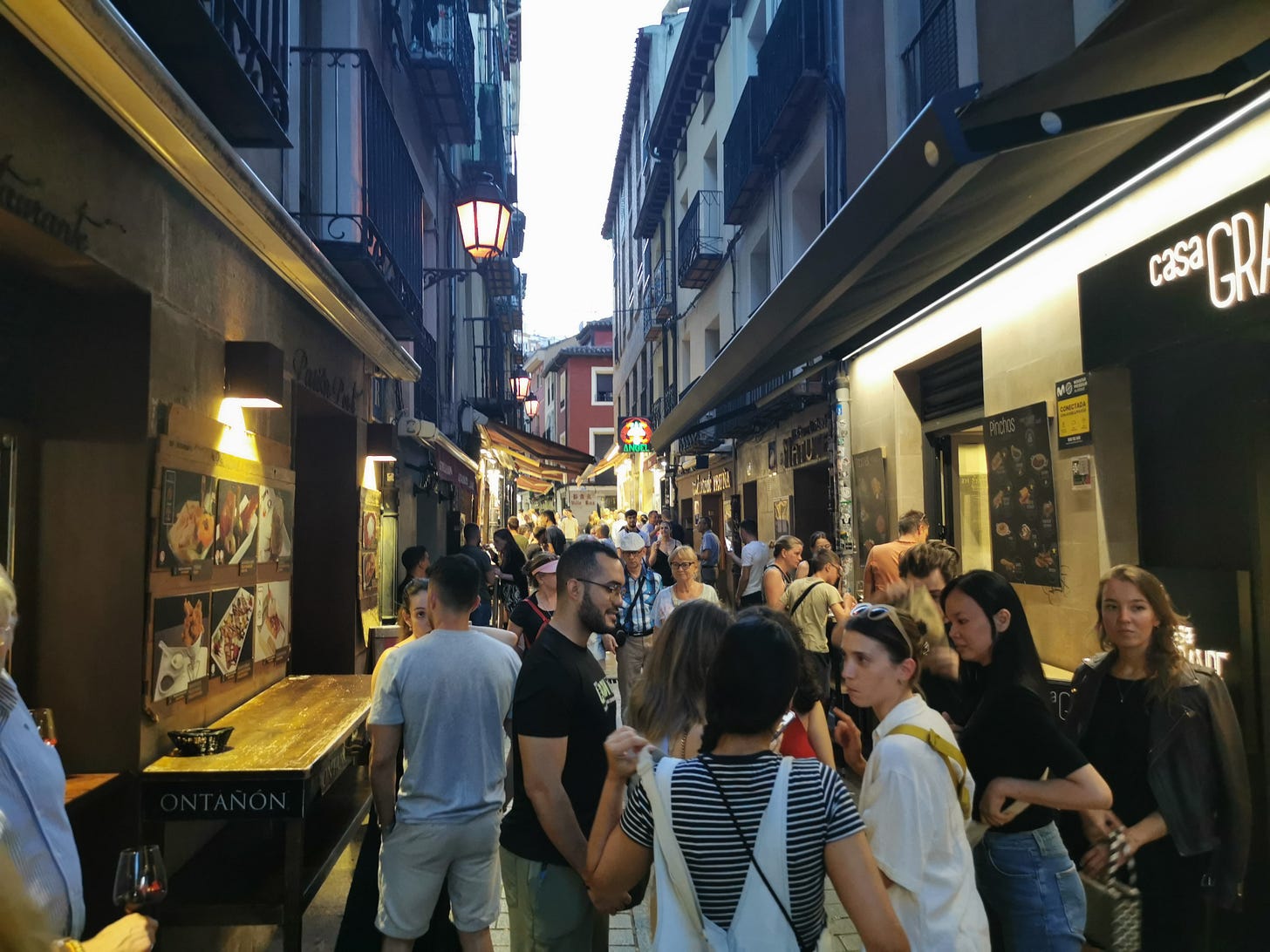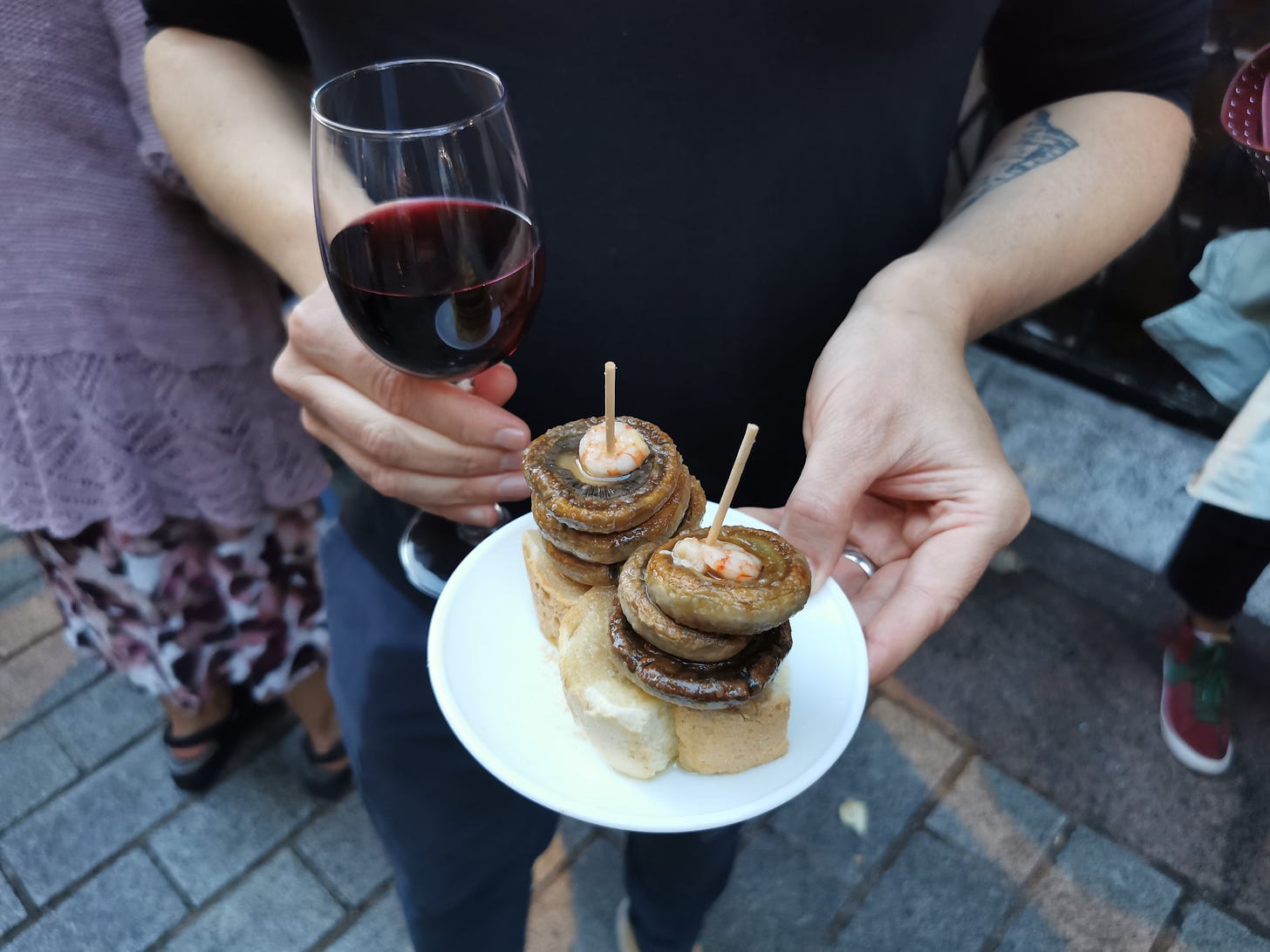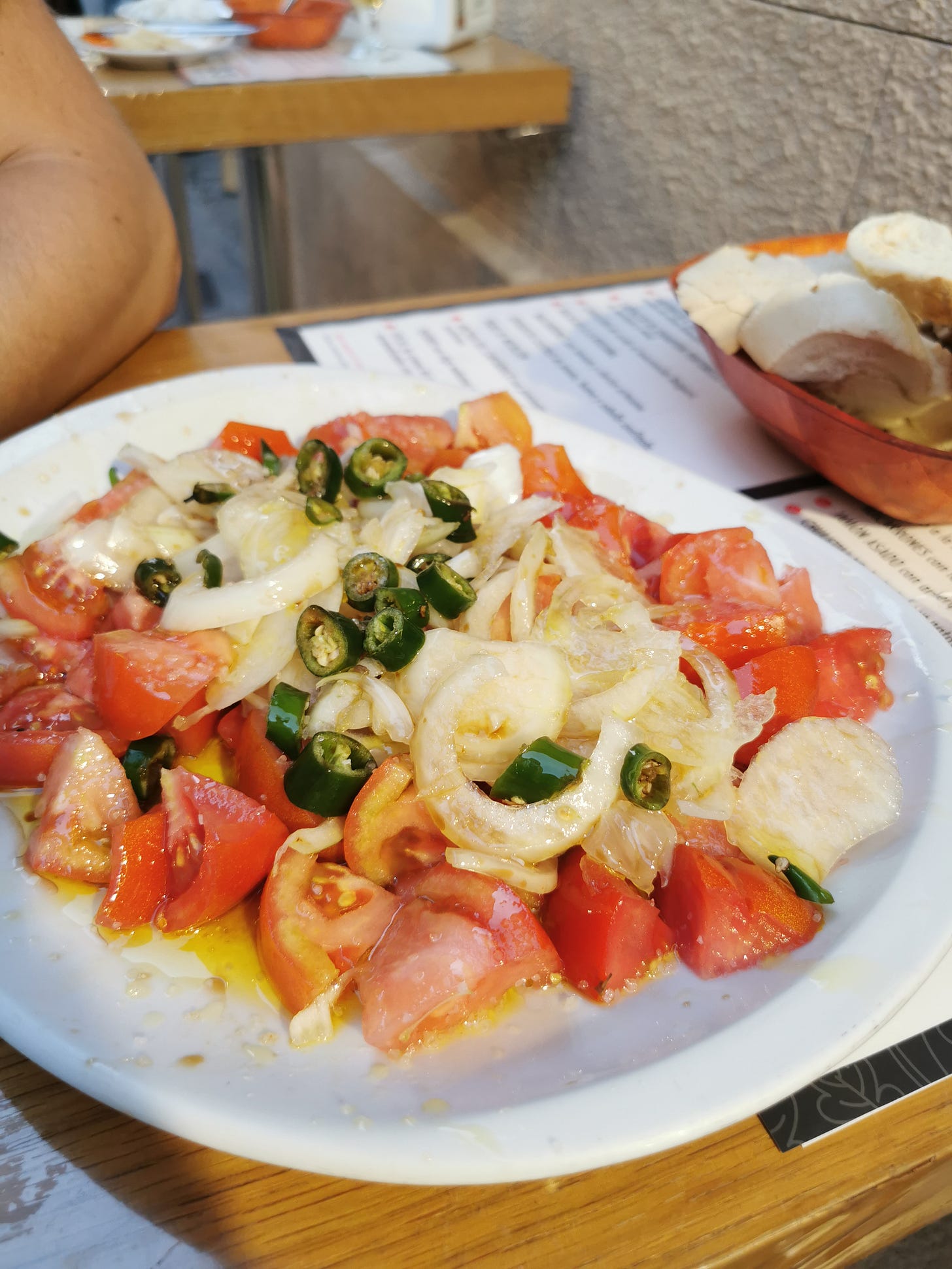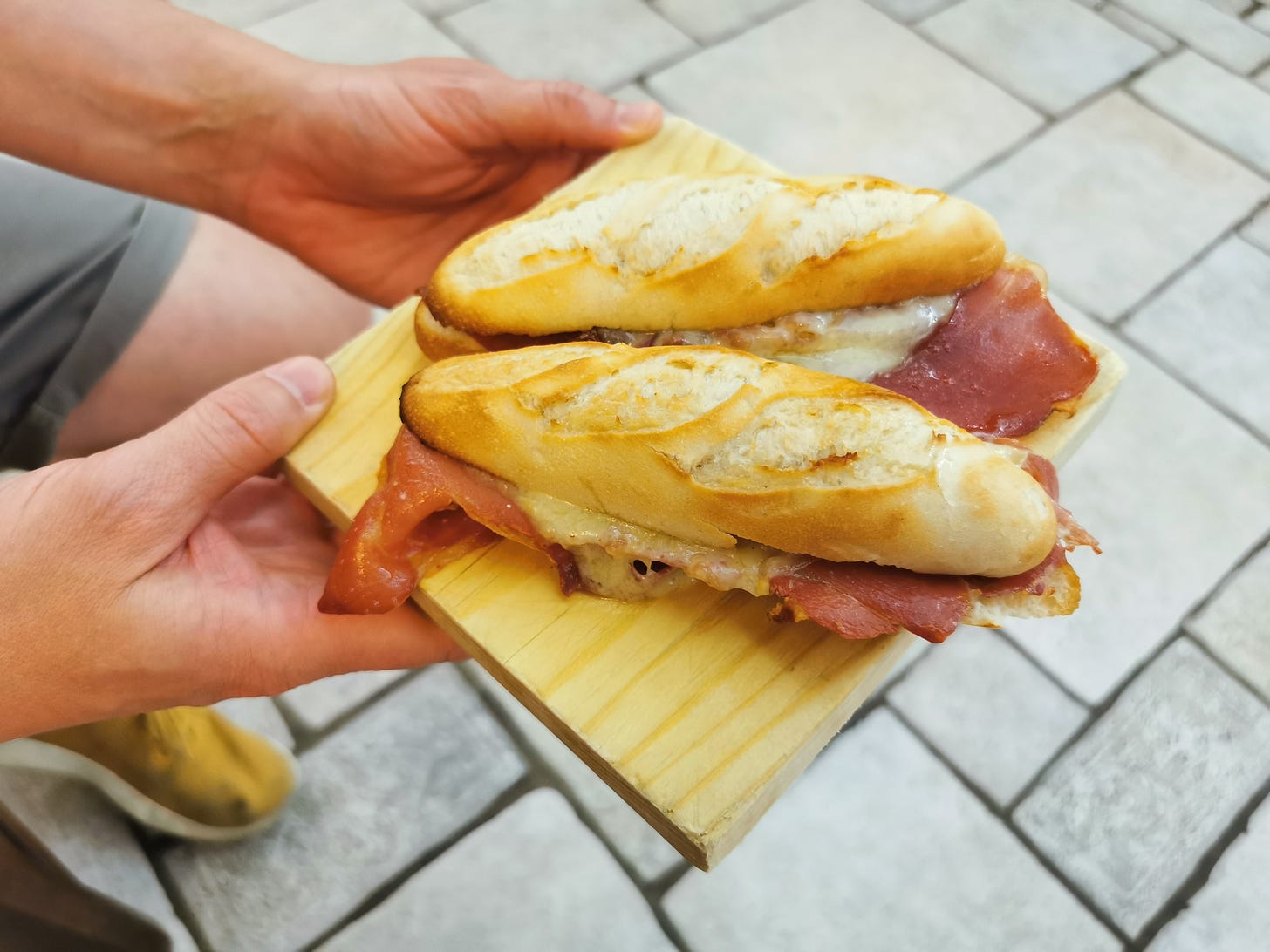When It Comes to Tapas, Logroño > San Sebastian
A travel guide and recipes from the *real* food capital of Spain
The nearer you get, the louder it becomes. A cacophony of noise I swear only the Spanish can make. Friends. Family. Laughter. And many uses of the word vale.
You turn the corner and there it is. Calle Laurel, Logroño’s food street. A 200 metre long street so narrow in some parts you can almost touch either side.
A street home to over 50 tiny pincho (the Basque version of tapas) bars each with its own speciality. Hundreds of people spill out onto the street, pinchos and wine in hand. Friends handing over cash for the bote (a slush fund / pot). People muscling their way to the bar, these well-oiled machines that churn out hundreds of the same pincho, night after night.
Despite the chaos, everyone gets served. Efficiency is king here, it’s amazing to watch.
And everyone eats and drinks very well.
This is Logroño, the capital of the Rioja wine region in north-central Spain.
It’s infuriatingly difficult to travel here (the nearest airports are Bilbao 1.5 hours north and Madrid four hours south) so you hear little other than Spanish. Perhaps the odd foreign accent from a pilgrim making their way across the Camino de Santiago (Logroño is a key stop on the Frances way).
But travel here you should.
I say this because Logroño was once my home. I spent six months living here a few years ago and it was one of the best decisions I’ve ever made.
If you are into food and wine, there is little better. Yes, San Sebastian is more well-known. Bilbao has the kudos. Barcelona has the Michelin stars.
But Logroño has all that and more. It’s also quieter. Less touristic. Cheaper.
Right now, I’m sitting in Logroño at the end of a long week of eating and drinking my way around the city. Visiting old haunts. Finding new ones thanks to our Logroñese friends.
And I want to share it all with you.
Today is part travel guide, part Logroño recipe book. All the addresses you need if you visit, and 10 recipes to recreate at home the best tapas in the town.
The first few recommendations and recipes will be for everyone, the rest are for my fantastic paid subscribers.
Getting access to the whole guide — and everything else The Sauce has to offer including my recent guide to Porto — costs $5 a month or $50 a year. I’d love to have you part of the gang.
I’ve also created a map of every place listed in the guide. So if you ever make it out to Logroño (and I suggest you do), you’ll not miss a thing.
If you’re reading this in your inbox, you will find the guide cuts off and these contents links don’t work. Open in your browser or the Substack app to make use of the below:
RECIPE CONTENTS
“Tio Agus” marinated pork bun from Bar San Lorenzo
Skewered mushrooms and prawns from Bar Soriano
Fresh tomato salad from Taberna de Baco
Jamón and cheese sandwiches from Pata Negra
Patatas Bravas from Bar Gargonich
Deep-fried calamari with bravas sauce and aioli from Torres Laurel
Flash-fried green peppers from La Ribera
Prawn and pineapple skewers from Juan y Pinchamé
The Gilda from Odisea
TRAVEL GUIDE CONTENTS
Tips for surviving a Logroño pincho crawl
The best of bars down Calle San Juan
…And the food and wine stores you need to know about
Tips for surviving a pincho crawl
Take it easy and take it slow. You might hit six or seven places in a night but you’ll have all evening to do it.
When it comes to drinks, order small. If you’re on the beer, order a corto — a very small pour, just enough to go with your pincho. Glasses of wine tend to be quite small on the trail. Do as the Spanish do and leave the spirits until later.
And don’t forget the standard Spanish tapas bar rules. Order at the bar, stand wherever there is room, and pay just before you leave.
A Calle Laurel pincho crawl
Every night starts the same. A Tio Agus at Bar Lorenzo.
This third-generation-owned bar named its star pincho after their uncle. The Tio Agus is a skewer of marinated pork grilled on a hot plancha until the outside chars, whacked in a small bun and liberally doused with a herby secret sauce designed by their grandfather, the OG Lorenzo owner.
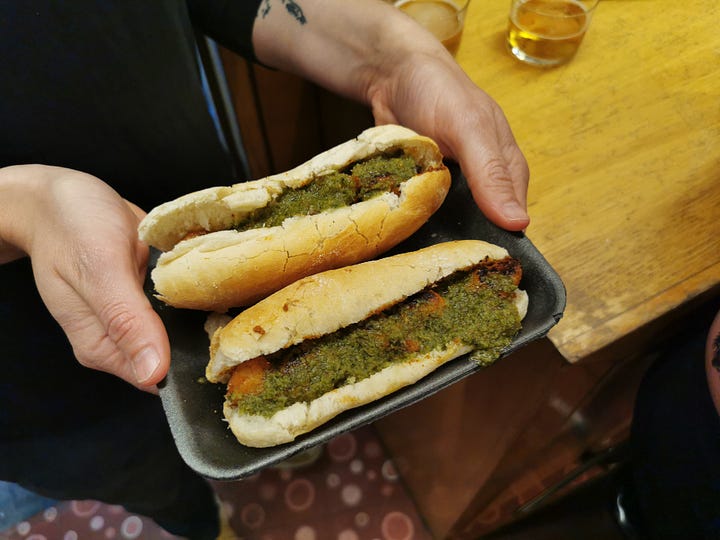
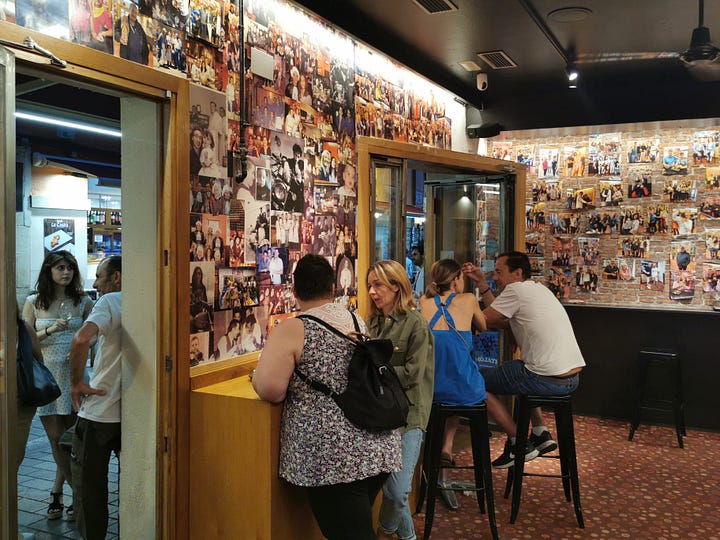
Many people have tried to replicate the Tio Agus and many have failed. Approximation is key here.
Start with small chunks of pork you steep in this pincho moruño marinade. Skewer. Hot griddle, pan or BBQ. Fry or grill until cooked and slightly charred.
As for the sauce, we’ll never know for sure but a good start is a handful of chopped fresh herbs including basil and oregano. A finely minced clove of fresh garlic. Enough extra virgin olive oil to turn it into a drizzly sauce. A tiny drop of red wine vinegar. A pinch of salt.
Small hot dog buns. Freshly grilled pork. Herb marinade on top.
Two doors down from San Lorenzo is probably the most famous pincho bar in Logroño, Bar Soriano. Not only do they have a speciality, it’s all they make. The bar is run by sibilings. One calls out orders to another at the end of the bar simply by shouting how many champis — mushrooms — the order is made of.
Dos! Quatro! Tres!
A trio of local mushrooms topped with a tiny prawn is skewered onto a slice of baguette and covered in an unholy amount of garlic oil. 7,000 of these go out of the door per week.
To drink, an organic joven (young) red wine from Rioja for €1.10 a glass.
Watching the chef is mesmerising. Scores of mushrooms — stalk cut out — are fried on the plancha, intermittently squirted with olive oil.
At home, a frying pan works just as well. Heat with olive oil. Fry the mushrooms on one side. Then the other. Turn back and forth until each mushroom is dark and softened.
Take a skewer pre-loaded with a cooked prawn. Skewer three mushrooms below it, finally stuck into a slice of baguette.
Melt a knob of butter or some olive oil. Add finely chopped parsley and a liberal amount of finely minced garlic (at least a clove per two people). Pour over the mushrooms and that, friends, is the essence of Bar Soriano.
It’s the summer. You know vegetables are not easy to come by on a Logroño pincho crawl so your next stop is La Taberna de Baco whose speciality is the deceptively simple tomato salad.
The heat of the summer feels like a furnace on the tiny Logroñese streets but it comes with its advantages. Enough sun to ripen Riojana tomatoes as big as a child’s head.
A tomato salad is less of a recipe and more of a state of mind. A summer state of mind.
Ripe tomatoes cut into random-sized chunks. (More than) a few slices of white onion. The fresh Guindilla pepper is a surprise, and in my opinion, too spicy. At home, I replace them with small green olives more similar to the tomato salad at another famous tapas bar, La Plata in Barcelona.
It’s the dressing that pulls the dish together. High-quality, grassy olive oil, a small amount of red wine or sherry vinegar, plenty of salt. Mix into the salad with your hands, ensuring that dressing finds its way into every nook and cranny.
On the corner stands Pata Negra which occupies a large (by Logroño standards) bar. The menu is long, almost overwhelmingly so. But its size is moot because everyone has the same thing.
A jamón serrano and melted tetilla cheese sandwich.
This nearly didn’t make the guide because it is not exactly a recipe. But I ate it almost every day. There is magic in meat and fat and childhood memories of ham and cheese toasties.
Take a small bread roll or baguette and cut it lengthways.
Source your meat. Make it thinly sliced. Jamón serrano, Jamón iberico, lomo or chorizo, or even ham will work. The choice is yours.
Forget slices of Velveeta or Dairylea and find something proper in the cheese department. In Rioja they use local tetilla, so-called because it looks like a breast.
It doesn’t matter what the cheese is so long as it easily melts. Cheddar, Gruyere, Fontina, Provolone, it all works.
Set your grill to high. A few slices of meat on the bottom bread slice will do the trick. Be generous.
Thin slices of cheese come next. Layer onto that ham.
The magic happens under the grill. Get the ham and cheese as close to the heating element as you can. Watch it. Once that cheese bubbles, take it out and make the sandwich.
To drink, do like they do in Pata Negra and take a glass of Crianza or Reserva Rioja with your sandwich of dreams.
On the bar of La Fontana stands a tower of Torreznos de Soria.
For even the most hardened of hedonists, torreznos are considered a treat. Strips of pork belly are deep-fried until crisp then thinly sliced into bite-size pieces.
Keep reading with a 7-day free trial
Subscribe to The Sauce to keep reading this post and get 7 days of free access to the full post archives.




